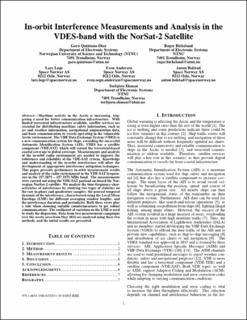| dc.contributor.author | Quintana DÃaz, Gara | |
| dc.contributor.author | Birkeland, Roger | |
| dc.contributor.author | Løge, Lars | |
| dc.contributor.author | Andersen, Even | |
| dc.contributor.author | Bolstad, Anton | |
| dc.contributor.author | Ekman, Torbjörn | |
| dc.date.accessioned | 2023-02-16T14:21:45Z | |
| dc.date.available | 2023-02-16T14:21:45Z | |
| dc.date.created | 2022-12-08T14:43:25Z | |
| dc.date.issued | 2022 | |
| dc.identifier.issn | 1095-323X | |
| dc.identifier.uri | https://hdl.handle.net/11250/3051616 | |
| dc.description.abstract | Maritime activity in the Arctic is increasing, triggering a need for better communication infrastructure. With limited terrestrial infrastructure available, satellite services are essential for distributing maritime safety information, such as ice and weather information, navigational augmentation data, and basic communication to vessels operating in the vulnerable Arctic environment. The VHF Data Exchange System (VDES) is a new communication system for ships, extending the successful Automatic Identification System (AIS). VDES has a satellite component (VDE-SAT) which will extend the terrestrial-based coastal coverage to global coverage. Measurements and analysis of the in-orbit radio environment are needed to improve the robustness and reliability of the VDE-SAT system. Knowledge and understanding of the in-orbit interference will allow the development of appropriate interference mitigation techniques. This paper presents preliminary in-orbit measurement results and analysis of the radio environment in the VDE-SAT frequencies in the 157.2875 - 157.3375 MHz band. The measurements were carried out using the VDE-SAT payload on-board the Norwegian NorSat-2 satellite. We analyze the time-frequency characteristics of interference by studying two types of statistics on the raw in-phase and quadrature samples: the general temporal dynamic of the interference, characterised using the Local Mean Envelope (LME) for different averaging window lengths; and the interference duration and periodicity. Both these views play a role when choosing suitable countermeasures to get robust communications. The coefficient of variation on the LME is used to study the dispersion. Data from two measurement campaigns over the Arctic area from May 2021 are analysed using these two methods, and the initial results are presented. | en_US |
| dc.language.iso | eng | en_US |
| dc.publisher | IEEE | en_US |
| dc.title | In-orbit Interference Measurements and Analysis in the VDES-band with the NorSat-2 Satellite | en_US |
| dc.title.alternative | In-orbit Interference Measurements and Analysis in the VDES-band with the NorSat-2 Satellite | en_US |
| dc.type | Peer reviewed | en_US |
| dc.type | Journal article | en_US |
| dc.description.version | acceptedVersion | en_US |
| dc.source.journal | IEEE Aerospace Conference. Proceedings | en_US |
| dc.identifier.doi | 10.1109/AERO53065.2022.9843810 | |
| dc.identifier.cristin | 2090742 | |
| dc.relation.project | Norges forskningsråd: 270959 | en_US |
| dc.relation.project | Norsk romsenter: TIN21024 | en_US |
| dc.relation.project | Norges forskningsråd: 223254 | en_US |
| cristin.ispublished | true | |
| cristin.fulltext | postprint | |
| cristin.qualitycode | 1 | |
